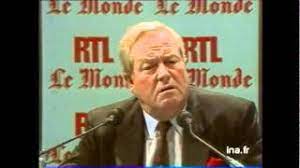The “detail” of Jean-Marie Le Pen
On the subject of the Nazi gas chambers, Jean-Marie Le Pen has recently stated:
If you take a thousand-page book on the Second World War, the concentration camps occupy two pages and the gas chambers ten or fifteen lines, and that’s called a detail.
He might have brought up some even harder hitting and more precise arguments, and referred to Eisenhower, Churchill, de Gaulle, Elie Wiesel, René Rémond, Daniel Goldhagen and the very text of the Nuremberg judgment.
Eisenhower, Churchill, de Gaulle
Three of the best known works on the Second World War are General Eisenhower’s Crusade in Europe (Doubleday [Country Life Press], New York 1948), Winston Churchill’s The Second World War (6 vol., Cassell, London 1948-1954), and the Mémoires de guerre of General de Gaulle (3 vol., Plon, Paris 1954-1959). In these three works not the least mention of the Nazi gas chambers is to be found[1].
Elie Wiesel
The same goes for the autobiographical account in which Elie Wiesel relates his experience of Auschwitz and Buchenwald (Night, Hill and Wang, New York 1960). In volume one of his memoirs he writes: “Let the gas chambers remain closed to prying eyes, and to imagination” (All Rivers Run to the Sea, Memoirs, Random House, New York 1995, p. 74).
René Rémond
In the third volume of his Introduction à l’histoire de notre temps (Introduction to the History of Our Time), René Rémond, who was then president of the commission on the history of the deportation within the Comité d’histoire de la Deuxième Guerre mondiale (Committee on the History of the Second World War), did not breathe a word of these gas chambers (Le XXe siècle de 1914 à nos jours [The 20th Century from 1914 to now], Le Seuil, Paris 1974). Fourteen years later, when he had become president of the Institut d’histoire du temps présent (Institute of the History of Present Times), he made no more mention of them than before in a 1,013-page work entitled Notre Siècle, de 1918 à 1988 (“Our Century, from 1918 to 1988”, Fayard, Paris 1988).
Daniel Jonah Goldhagen
Since March 1996, the Jewish-American historian Daniel Jonah Goldhagen has progressively become the darling of the media the world over, thanks to his book Hitler’s Willing Executioners / Ordinary Germans and the Holocaust (Little, Brown [Abacus], London 1997 [1996], XIV-634 p.; first published in the US by Alfred A. Knopf, March, 1996). If he does mention the Nazi gas chambers, it is in order to say little more than that “their efficiency [has been] greatly overstated” (p. 10) and that they have always been, and wrongly, “the overwhelming focus of popular and even scholarly attention” (p. 165). He goes as far as to reckon that “gassing was really epiphenomenal to the Germans’ slaughter of Jews” (p. 533, n. 81) and that “the imbalance of attention devoted to the gas chambers needs to be corrected” (p. 535).
The Nuremberg judgment
The Fabius-Gayssot act of 1990 forbids the “disputing” solely of the parts of the Nuremberg judgment (September 30 and October 1, 1946) relating to “crimes against humanity”, amongst which the use of homicidal gas chambers. But it can be remarked that, of the 84,000 words of the judgment’s French version, only 520, extremely vague, are devoted to the gas chambers. That amount represents 1/160th of the text, or 0.62%. In other words, 99.38% of the judgment does not deal with these gas chambers.[2]
Why such discretion?
As for the various reasons why Eisenhower, Churchill, de Gaulle, Elie Wiesel, René Rémond, Daniel Goldhagen and the very text of the Nuremberg judgment are so reserved on the subject of the Nazi gas chambers, the revisionists have explanations which the Fabius-Gayssot Act forbids them to put forth.
December 20, 1997
_________________
[1] Crusade in Europe by Eisenhower (1948) is a book of 559 pages; the six volumes of The Second World War by Churchill (1948-1954) total 4,448 pages, and de Gaulle’s Mémoires de guerre (three volumes, 1954-1959), 2,054, making for an overall mass of 7,061 pages (not including the introductory parts) published from 1948 to 1959, in which one will find no mention either of Nazi “gas chambers”, a “genocide” of the Jews or the “six million” Jewish victims of the war.
[2] The English version appears in volume I (p. 171-341) of the 42-volume set published as Trial of the Major War Criminals before the International Military Tribunal (IMT), Nuremberg 1947 [ed.].

